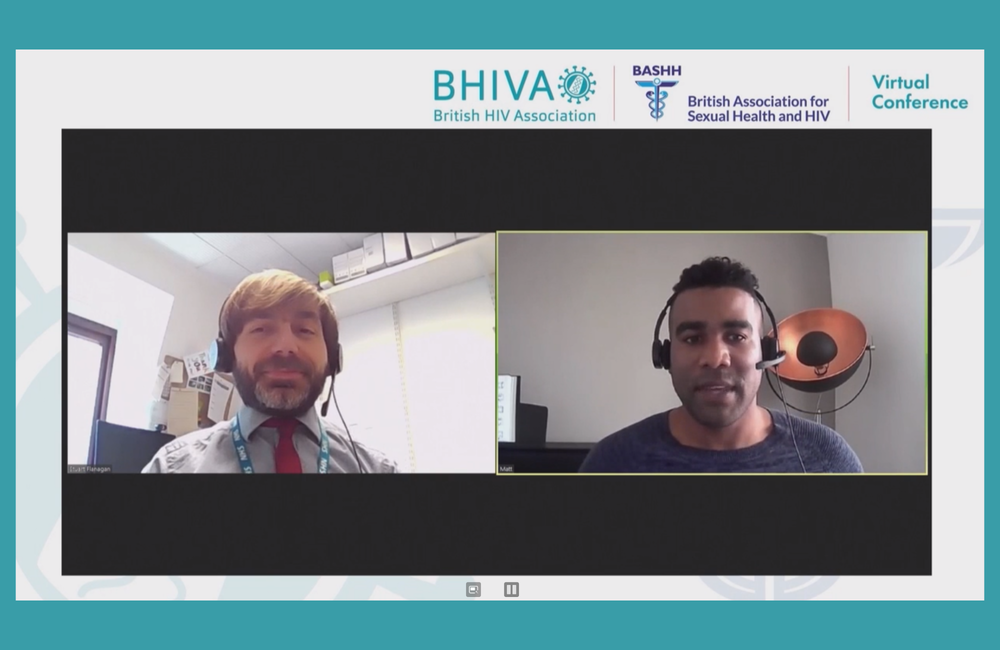
The large shift from face-to-face to telephone appointments in HIV services over the last year has identified some advantages, possibilities and challenges, explored in numerous presentations at the joint British HIV Association (BHIVA) and British Association of Sexual Health and HIV (BASHH) conference last week.
Ammi Shah of Public Health England presented national data, showing that there were 9% fewer HIV consultations and 6% fewer people seen in HIV services in January to September 2020, by comparison with the same period in 2019. This suggests gaps in care for some individuals, but that services had overall found ways of adapting, primarily by switching to phone consultations. The number of video consultations was minimal.
There was a marked drop off in consultations between March and May, with recovery over the summer. Fewer new patients and patients who were stable on therapy had appointments, while patients with more complex needs continued to be seen.
Several surveys of patient preferences were presented. The largest was of 795 people (16% of the patient cohort) at the Bloomsbury Clinic in central London and its associated services in Surrey. Over half of respondents had experienced a telephone consultation for the first time due to COVID-19, which 85% rated as ‘good’, ‘very good’ or ‘excellent’. A similar proportion would be happy to have a phone consultation again. For the future, the survey proposed a hybrid model – face-to-face reviews once a year or even once every two years, in combination with virtual appointments every six months – which 80% said would be acceptable. A crucial factor for patients was whether they would generally see the same clinician at each consultation.
A survey from Derby was much smaller (41 respondents) but the sample was representative of this somewhat different patient cohort. Most people were willing to have phone consultations (39 people) or video consultations (33 people). Asked about their preferred medium for consultations, 13 preferred face-to-face, 8 telephone, 6 video and 14 did not express a preference. In other words, more preferred a virtual consultation (8+6) than a face to face meeting (13). A survey in Leeds found that contrary to received wisdom, young people had more concerns about phone or video consultations than older people, while Black patients were more likely to prefer remote consultations than White patients.
Concerns are often raised about inequalities in access to technology. The Mortimer Market survey found that all but 22 patients (2.8%) had a smartphone which they could use for confidential calls. The Derby clinicians found that 38 of 42 respondents had access to a smartphone or computer with a webcam.
There are other barriers to attending in person – several of the surveys highlighted the time and cost associated with travelling to appointments, or with arranging time off work. For example, five Derby respondents said they had difficulties travelling to the clinic, similar to the number lacking the technology for a video consultation. Fifteen per cent at the Bloomsbury Clinic spend more than £10 on transport to a face-to-face appointment.
However, some respondents to various surveys highlighted difficulties with phone or video appointments, including finding a private space, phone reception and other technical challenges. Some mentioned not having the social aspect of seeing peers and staff, or concerns about missing out on blood tests.
Impact of missed blood tests
In line with BHIVA guidance, many services discouraged patients from coming in for routine viral-load monitoring (usually every six months for many people) last year. Several posters reported on whether this led to problems and the results were generally reassuring.
In Newcastle, 96% had a viral load below 200 before the lockdown, and 94% afterwards. Similarly, 82% had a viral load below 50 before, and 84% after. Viral load did increase in 9% of patients, but frequently, this was not entirely unexpected – the individual had reported problems with adherence or had previously had an unsuppressed viral load.
Similarly, clinicians in Manchester reviewed 42 cases in which viral load was detectable by the time it was checked when restrictions were eased. In 39 of the 42 cases, there was a cause unrelated to service restrictions – such as someone taking treatment for the first time or a viral blip. There were three cases which appeared to be linked to service restrictions. One patient said they couldn’t access the clinic to get more medication, while another needed a language interpreter for their phone consultation and there seems to have been a misunderstanding about the information given. A third patient had known adherence issues, but developed new resistance which may have been avoided or picked up sooner if blood monitoring hadn’t been reduced.
Shah A et al. Impact of the COVID-19 pandemic measures on HIV consultations in England. Fifth Joint Conference of the British HIV Association (BHIVA) and the British Association for Sexual Health and HIV (BASSH), abstract O011, 2021.
Flanagan S et al. Planning Post-Pandemic HIV Services –the Patients’ Perspective. Fifth Joint Conference of the British HIV Association (BHIVA) and the British Association for Sexual Health and HIV (BASSH), abstract O012, 2021.
Singleton A et al. Patient preferences for routine HIV outpatient consultations (virtual or face to face?). Fifth Joint Conference of the British HIV Association (BHIVA) and the British Association for Sexual Health and HIV (BASSH), abstract P183, 2021.
Astill N et al. What do patients really think about remote consultations? Fifth Joint Conference of the British HIV Association (BHIVA) and the British Association for Sexual Health and HIV (BASSH), abstract P165, 2021.
Welsh S et al. Deferral of routine HIV viral load monitoring during the COVID-19 pandemic. Fifth Joint Conference of the British HIV Association (BHIVA) and the British Association for Sexual Health and HIV (BASSH), abstract P026, 2021.
Wood C et al. The impact of the COVID-19 pandemic on HIV care in a large city centre service. Fifth Joint Conference of the British HIV Association (BHIVA) and the British Association for Sexual Health and HIV (BASSH), abstract P099, 2021.
